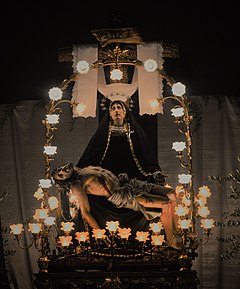This article needs additional citations for
verification. (April 2022) |
| Holy Week in Ruvo di Puglia | |
|---|---|
 | |
| Official name | Settimana Santa di Ruvo di Puglia |
| Also called | Ruvestine Holy Week |
| Observed by | Ruvo di Puglia, Italy |
| Type | Christian |
| Celebrations | Processions |
| Begins | Friday of Passion (last Friday before Easter week) |
| Ends | Easter Monday |
| Frequency | Annual |
| First time | 16th or 17th century |
| Started by | Ancient local Confraternities |
The rites of the Holy Week in Ruvo di Puglia are the main event that takes place in the Apulian town. Folklore and sacred or profane traditions, typical of the ruvestine tradition, represent a great attraction for tourists from neighboring cities and the rest of Italy and Europe, [1] and have been included by the I.D.E.A. among the events of the intangible heritage of Italy.
History
The Confraternities of Ruvo
The proof of the existence of the first Ruvestines confraternities can be found in the polyptych, a Byzantine work signed Z. T., depicting the Madonna with Child and confreres, in which the inscription "Hoc opus fieri fec(e)runt, confratres san(c)ti Cleti, anno salut(i)s 1537" and preserved in the church of Purgatory, in the left aisle, the one dedicated to Saint Anacletus.
The birth of the ruvestine Confraternities dates back to the period of the counter-reformation and currently there are only four associations still active. As reported by the polyptych, the first confraternity of which we know is the Confraternity of Saint Anacletus, whose praying brothers are represented in the painting dressed in a white sack and hooded. In the same period, Ruvo saw the birth of the Confraternity of the Holy Name of Jesus in the former church of the Rosary, now of San Domenico, by the Dominican fathers.
See also
References
- ^ Di Palo, Francesco (1999). I Giorni del Sacro (in Italian). Terlizzi: Centro Stampa Litografica. p. 6.
This article needs additional citations for
verification. (April 2022) |
| Holy Week in Ruvo di Puglia | |
|---|---|
 | |
| Official name | Settimana Santa di Ruvo di Puglia |
| Also called | Ruvestine Holy Week |
| Observed by | Ruvo di Puglia, Italy |
| Type | Christian |
| Celebrations | Processions |
| Begins | Friday of Passion (last Friday before Easter week) |
| Ends | Easter Monday |
| Frequency | Annual |
| First time | 16th or 17th century |
| Started by | Ancient local Confraternities |
The rites of the Holy Week in Ruvo di Puglia are the main event that takes place in the Apulian town. Folklore and sacred or profane traditions, typical of the ruvestine tradition, represent a great attraction for tourists from neighboring cities and the rest of Italy and Europe, [1] and have been included by the I.D.E.A. among the events of the intangible heritage of Italy.
History
The Confraternities of Ruvo
The proof of the existence of the first Ruvestines confraternities can be found in the polyptych, a Byzantine work signed Z. T., depicting the Madonna with Child and confreres, in which the inscription "Hoc opus fieri fec(e)runt, confratres san(c)ti Cleti, anno salut(i)s 1537" and preserved in the church of Purgatory, in the left aisle, the one dedicated to Saint Anacletus.
The birth of the ruvestine Confraternities dates back to the period of the counter-reformation and currently there are only four associations still active. As reported by the polyptych, the first confraternity of which we know is the Confraternity of Saint Anacletus, whose praying brothers are represented in the painting dressed in a white sack and hooded. In the same period, Ruvo saw the birth of the Confraternity of the Holy Name of Jesus in the former church of the Rosary, now of San Domenico, by the Dominican fathers.
See also
References
- ^ Di Palo, Francesco (1999). I Giorni del Sacro (in Italian). Terlizzi: Centro Stampa Litografica. p. 6.